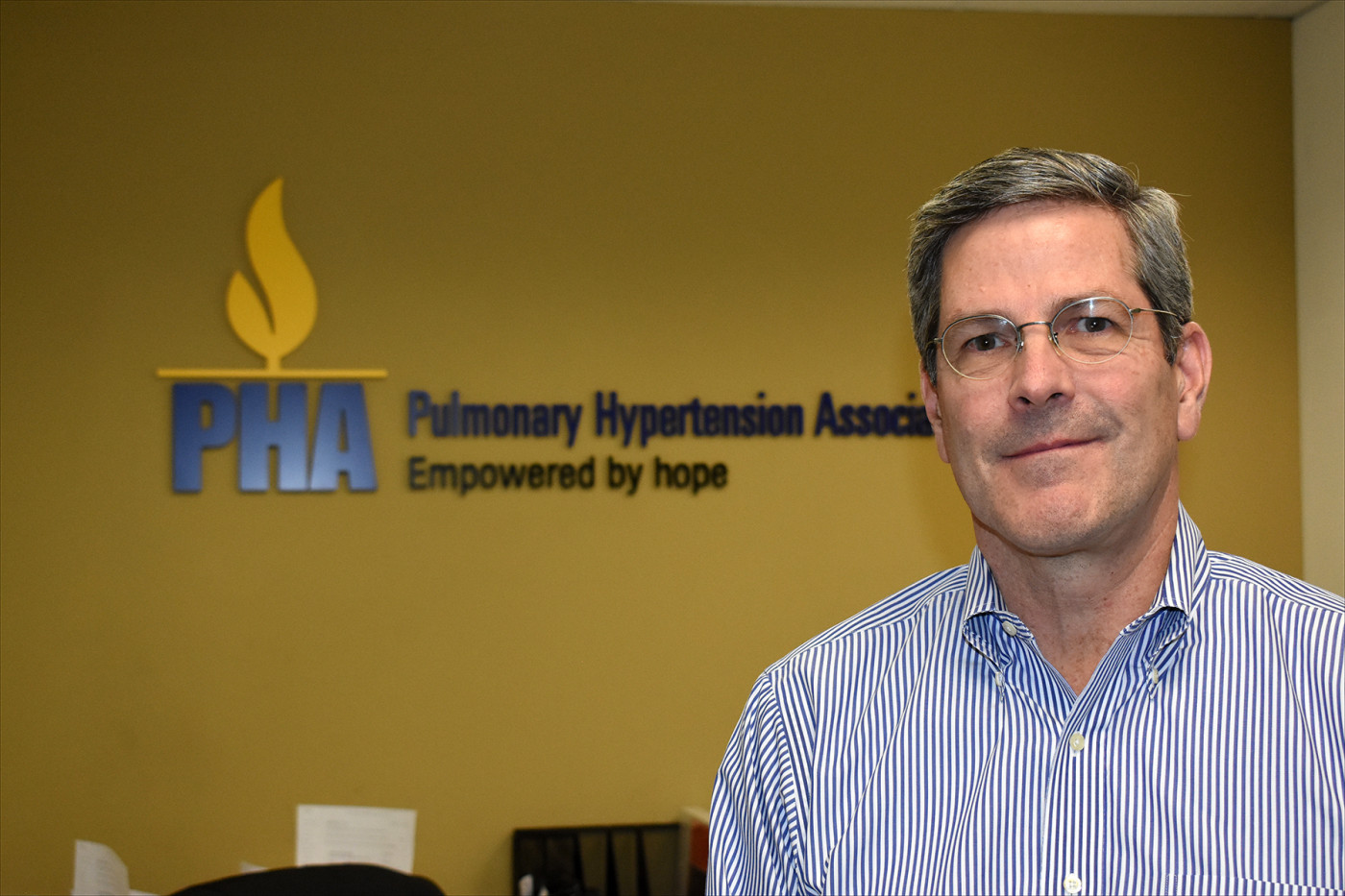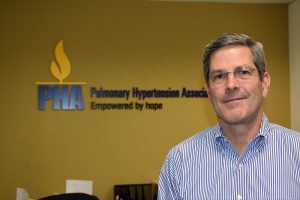Access to Costly Therapies Top Concern of PH Patients in US, PHA’s Brad Wong Says

Brad Wong, CEO of the Maryland-based Pulmonary Hypertension Association. (Photo by Larry Luxner)
Like many rare disease charities, the Pulmonary Hypertension Association (PHA) was formed in 1991 by four women sitting around a kitchen table in Florida, hoping for a cure.
Yet the PHA is probably the only patient advocacy group that actually preserved its original kitchen table and chairs — and made them the centerpiece of its national headquarters.
The small oval table, adorned with glass trophies and framed certificates, is the first thing Brad A. Wong shows visitors as part of a quick tour of the PHA office, located on the tenth floor of an office building in Silver Spring, Maryland.
“Our mission is to extend and enhance the lives of those affected by pulmonary hypertension,” Wong told Pulmonary Hypertension News during an interview. “Back then, there was absolutely no knowledge about the disease, so these women realized they needed to connect with other patients.”
From the beginning, the association gave patients, caregivers, and healthcare providers equal importance, said Wong, who headed the American Academy of Ophthalmology before joining the PHA in June 2016 as the second chief executive in the association’s history.
“Not only did patients and their families or caregivers not know each other, but their physicians didn’t even know other physicians,” he said. “There are medical societies for the clinicians, and caregiver support groups like Alzheimer’s, and then there are patient advocacy groups. So when our founders set up PHA, they knew it would be a blend of all three; in some ways, that makes us a pretty unique organization.”
Wong added: “As part of that early activity, they founded a newsletter called Pathlight. That’s still our signature magazine today, published four times a year.”
These days, the PHA employs 34 staffers, and operates on an annual budget of just under $10 million. The organization charges a nominal membership fee of $15 a year, and has 16,000 people in its community — patients, healthcare providers, friends, and supporters.
PHA pushes to raise awareness
PHA holds an international conference every two years. The next one, set for June 12-14, 2020, will take place in Anaheim, California, and is expected to attract 1,400 participants.
“Because it’s such a rare disease, oftentimes healthcare providers don’t think about PH as a potential cause of whatever’s ailing a patient. A lot of its symptoms resemble other diseases, such as asthma. And the way medicine is practiced in the U.S., doctors don’t have the time they used to have for patients,” Wong said.
“That’s why we work so hard to raise levels of awareness among physicians. We want them to get the message that sometimes it is PH, and to know when to refer patients for additional diagnostics. But we want them to at least suspect PH and know what kinds of tests to order.”
The same goes for the general public, he said.
“We want people to know that PH exists, and that if you’re short of breath but you think you have asthma and it’s not getting better, that it could be PH.”
The World Health Organization (WHO) has classified PH into four groups. Roughly 30,000 Americans, mostly women, have either WHO Group 1, pulmonary arterial hypertension (PAH), or WHO Group 4, chronic thromboembolic PH (CTEPH), the most severe forms of the disease. However, the number rises into the millions when including WHO Group 2 — left-heart disease — which alone accounts for 68% of all PH cases, as well as PH due to lung disease or unknown causes.
If not properly treated, people with PH can expect to live an average of 2.8 years following diagnosis. But some patients — including more than a few PHA board members — have been living with the disease for at least 30 years.
“Many patients, particularly when they’re newly diagnosed, feel a sense of isolation, which causes depression and other issues,” Wong said. “That’s why one of the most important things we do at PHA is provide support.”
14 approved therapies available
To that end, he said, the organization offers over 200 local support groups nationwide, as well as 500 to 700 PHA-trained group leaders. Those groups generate between 10,000 and 13,000 patient encounters a year. Volunteers also staff a toll-free number around the clock for PH patients whose health or geographic distance prevents them from attending meetings in person.
“We also have a Spanish-speaking line. That was one of the first programs the founders created,” Wong said. “We also have email mentoring and Facebook support groups for different categories of people, such as long-term survivors and parents of kids with PH.”
Since 2014, the PHA has developed a network of 75 accredited, specialized clinics as part of its PH Care Centers initiative. This includes 54 adult centers of comprehensive care, 13 adult regional clinical programs, and eight pediatric centers across the United States.
To be accredited, said Wong, PH centers must demonstrate expertise in PH and a commitment to providing expert-level care, evaluating PH patients based on published, evidence-based guidelines, and assembling a team of healthcare professionals dedicated to the disease.
“A lot of healthcare providers still think ‘you need to exercise more, it’s in your head, you’re a little overweight.’ That still happens a great deal,” he said. “We’re trying to get healthcare providers to realize it actually could be more serious.”
Asked if he’s succeeding, Wong replied: “I wish we could say that we have, but we’ll have to keep fighting and make sure our message gets through.”
The good news, he said, is that 14 therapies are today available to treat PH — up from zero only a few years ago. The standard of care has evolved from monotherapies to multiple therapies, with many of these new treatments costing upward of $250,000 a year.
Leading treatments include Tracleer (bosentan), by Actelion Pharmaceuticals, which improves the ability of PAH patients to exercise and slows disease progression. Another is Remodulin (treprostinil), by United Therapeutics, given to PAH patients to widen blood vessels and help blood flow through the lungs more efficiently.
Many PAH patients are also on Letairis (ambrisentan), marketed by Gilead in the U.S., as a monotherapy. The FDA approved its use in combination with tadalafil (marketed as Adcirca by Eli Lilly) in October 2015.
Keeping costs down a huge priority
“The PH space really benefitted from the Orphan Drug Act [of 1983], which provided incentives to research and develop rare disease medicines,” Wong said. “We were fortunate that some potential drug candidates were identified through the act. Pharmaceutical companies realized there was an unmet need for these patients and began developing therapies.”
At least eight generic versions of ambrisentan and bosentan are now on the market, following the recent expiration of their patents. But how these options will affect PH patients is still unclear, Wong said.
“This is really new and we’re still trying to figure out what’s going on, because the business model of generics isn’t necessarily to provide the same level of support that regular companies do,” he said. “We need innovation, we need therapies, and we need to figure out how to pay for all this — but it’s going to be an evolution.”
Average drug spending for patients with PAH in 2016 ranged from $103,464 to $196,560 a year, according to America’s Health Insurance Plans, an industry organization of health insurers. According to another 2016 report, two of the five most expensive therapies covered by Medicare were PAH treatments — Remodulin at $144,070 per patient per year, and Tyvaso (inhaled treprostinil) at $107,489.
PAH patients still pay an average $7,000 to $10,000 or more annually in out-of-pocket costs for their medications alone, Wong said.
“The biggest issue for our community is access to therapies,” he said, faulting the lack of universal healthcare in the United States. “Our system is fragmented between private and government insurance, and it has a lot of middlemen. These are highly expensive therapies — often in the six figures — so any percentage of that is too high for a population of patients who are predominantly not working or on disability.”
The PHA devotes a great deal of energy trying to “reduce anxieties and making sure patients don’t lose access” to the therapies they need by organizing events on Capitol Hill, Wong said, and educating lawmakers about PH.
“It’s critically important to figure out an appropriate policy on how to handle expensive therapies, but that doesn’t mean a lot to patients who need access their therapies next month, because they can deteriorate very quickly,” he said. “If there’s a disruption of therapy, they don’t get their health back.”











